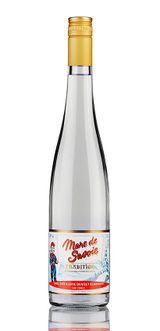Pomace: Difference between revisions
Uncle Jesse (talk | contribs) No edit summary Tag: Reverted |
Uncle Jesse (talk | contribs) No edit summary |
||
| (One intermediate revision by the same user not shown) | |||
| Line 1: | Line 1: | ||
[[file:Marc-de-Savoie.jpg|thumb|160px|right|Marc de Savoie]] | |||
The residue of pressed [[pulp]], skins and pips of [[Apple_(fruit)|apples]], [[Grape_(fruit)|grapes]] or any [[fruit]] after pressing. When pressed under great pressure, a pomace cake or brick results. | The residue of pressed [[pulp]], skins and pips of [[Apple_(fruit)|apples]], [[Grape_(fruit)|grapes]] or any [[fruit]] after pressing. When pressed under great pressure, a pomace cake or brick results. | ||
Pomace from appropriate fruit can be [[Amelioration|ameliorated]] with [[sugar]], [[acid]], water, and [[Yeast_nutrient|yeast nutrients]] (possibly acid and [[tannin]] will also be required) and a second [[wine]] can be made. The pomace provides enough flavor for a reduced volume of wine and should contain enough viable [[yeast]] (assuming the pulp was pressed after an initial period of [[fermentation]]) to continue fermentation. | Pomace from appropriate fruit can be [[Amelioration|ameliorated]] with [[sugar]], [[acid]], water, and [[Yeast_nutrient|yeast nutrients]] (possibly acid and [[tannin]] will also be required) and a second [[wine]] can be made. The pomace provides enough flavor for a reduced volume of wine and should contain enough viable [[yeast]] (assuming the pulp was pressed after an initial period of [[fermentation]]) to continue fermentation. | ||
[[ | Grape pomace has traditionally been used to produce [[pomace brandy]] (such as [[grappa]], orujo, törkölypálinka, zivania). Today, it is mostly used as fodder, as fertilizer, or to extract bioactive compounds like polyphenols from it. | ||
[[Category:Wine]] | |||
[[Category:Glossary]] | [[Category:Glossary]] | ||
Latest revision as of 23:13, 29 December 2022
The residue of pressed pulp, skins and pips of apples, grapes or any fruit after pressing. When pressed under great pressure, a pomace cake or brick results.
Pomace from appropriate fruit can be ameliorated with sugar, acid, water, and yeast nutrients (possibly acid and tannin will also be required) and a second wine can be made. The pomace provides enough flavor for a reduced volume of wine and should contain enough viable yeast (assuming the pulp was pressed after an initial period of fermentation) to continue fermentation.
Grape pomace has traditionally been used to produce pomace brandy (such as grappa, orujo, törkölypálinka, zivania). Today, it is mostly used as fodder, as fertilizer, or to extract bioactive compounds like polyphenols from it.
